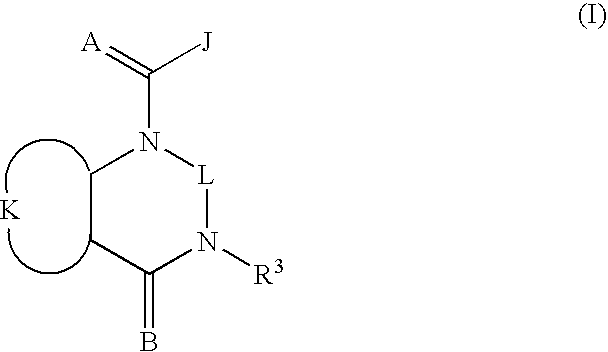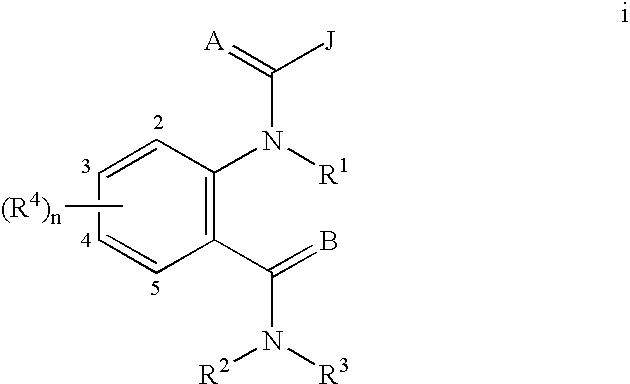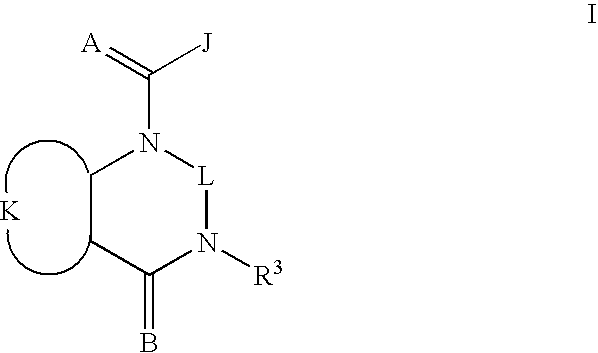Quinazoline(di)ones for invertebrate pest control
- Summary
- Abstract
- Description
- Claims
- Application Information
AI Technical Summary
Problems solved by technology
Method used
Image
Examples
example 1
6-Bromo-1-[[3-bromo-1-(3-chloro-2-pyridinyl)-1H-pyrazol-5-yl]carbonyl]-8-methyl-3-(1-methylethyl)-2,4(1H,3H)-quinazolinedione
Step A: Preparation of 3-bromo-N,N-dimethyl-1H-pyrazole-1-sulfonamide
[0133] To a solution of N-dimethylsulfamoylpyrazole (44.0 g, 0.251 mol) in dry tetrahydrofuran (500 mL) at −78° C. was added dropwise a solution of n-butyllithium (2.5 M in hexane, 105.5 mL, 0.264 mol) while maintaining the temperature below −60° C. A thick solid formed during the addition. Upon completion of the addition the reaction mixture was maintained for an additional 15 minutes, after which time a solution of 1,2-dibromo-tetrachloroethane (90 g, 0.276 mol) in tetrahydrofuran (150 mL) was added dropwise while maintaining the temperature below −70° C. The reaction mixture turned a clear orange; stirring was continued for an additional 15 minutes. The −78° C. bath was removed and the reaction was quenched with water (600 mL). The reaction mixture was extracted with dichloromethane (4×...
example 2
Preparation of 1-[[3-Bromo-1-(3-chloro-2-pyridinyl)-1H-pyrazol-5-yl]carbonyl]-2,3-dihydro-8-methyl-3-(1-methylethyl-4(1H-quinazolinone
Step A: Preparation of 2,3-dihydro-8-ethyl-3-(1-methylethyl)-4(1H)-quinazoline
[0141] To a solution of 2-amino-3-methyl-N-(1-methylethyl)benzamide (0.5 g, 2.6 mmol) in ethanol (10 mL) was added paraformaldehyde (78 mg, 2.6 mmol) and p-toluenesulfonic acid (18 mg, 95 μmol) and the mixture was heated at reflux until it became clear (approximately 4 hours). The solvent was removed under reduced pressure to give the title compound (95% pure) which was used without further purification.
1H NMR (CDCl3) δ 7.9-7.8 (d,1H), 7.2-7.1 (d,1H), 6.83 (t,1H), 4.97 (m,1H), 4.57 (s,2H), 2.17 (s,3H), 1.22 (d,6H).
Step B: Preparation of 1-[[3-bromo-1-(3-chloro-2-pyridinyl)-1H-pyrazol-5-yl]carbonyl]-2,3-dihydro-8-methyl-3-(1-methylethyl)-4H)-quinazolinone
[0142] To a solution of 3-bromo-1-(3-chloro-2-pyridinyl)-1H-pyrazole-5-carboxylic acid (787 mg, 2.45 mmol) (i.e. the...
example 3
Preparation of 3-Bromo-1-(3-chloro-2-pyridinyl)-1H-pyrazole-5-carboxylic acid
Step A: Preparation of Ethyl 2-(3-Chloro-2-pyridinyl)-5-oxo-3-pyrazolidinecarboxylate
[0144] A 2-L four-necked flask equipped with a mechanical stirrer, thermometer, addition funnel, reflux condenser, and nitrogen inlet was charged with absolute ethanol (250 mL) and an ethanolic solution of sodium ethoxide (21%, 190 mL, 0.504 mol). The mixture was heated to reflux at about 83° C. It was then treated with 3-chloro-2(1H)-pyridinone hydrazone (68.0 g, 0.474 mol). The mixture was re-heated to reflux over a period of 5 minutes. The yellow slurry was then treated dropwise with diethyl maleate (88.0 mL, 0.544 mol) over a period of 5 minutes. The reflux rate increased markedly during the addition. By the end of the addition all of the starting material had dissolved. The resulting orange-red solution was held at reflux for 10 minutes. After being cooled to 65° C., the reaction mixture was treated with glacial ace...
PUM
| Property | Measurement | Unit |
|---|---|---|
| Length | aaaaa | aaaaa |
| Temperature | aaaaa | aaaaa |
| Temperature | aaaaa | aaaaa |
Abstract
Description
Claims
Application Information
 Login to View More
Login to View More - R&D
- Intellectual Property
- Life Sciences
- Materials
- Tech Scout
- Unparalleled Data Quality
- Higher Quality Content
- 60% Fewer Hallucinations
Browse by: Latest US Patents, China's latest patents, Technical Efficacy Thesaurus, Application Domain, Technology Topic, Popular Technical Reports.
© 2025 PatSnap. All rights reserved.Legal|Privacy policy|Modern Slavery Act Transparency Statement|Sitemap|About US| Contact US: help@patsnap.com



